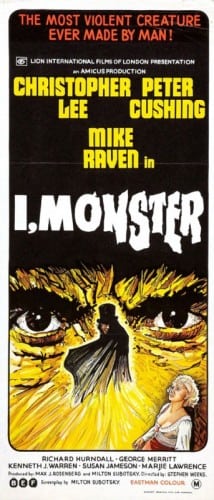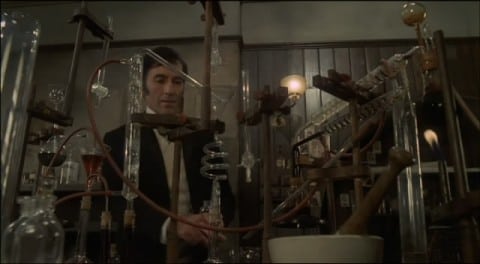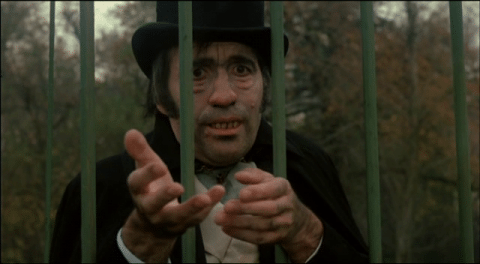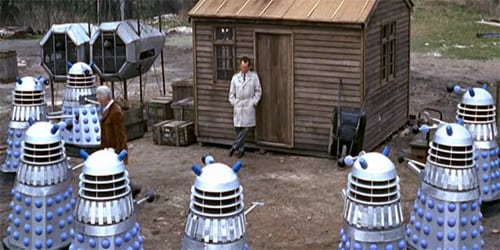I Monster (1971)
Directed by: Stephen Weeks
Written by: Milton Subotsky, Robert Louis Stevenson
Starring: Christopher Lee, Mike Raven, Peter Cushing, Richard Hurndall
UK
AVAILABLE ON DVD
RUNNING TIME: 80 min/75 min
REVIEWED BY: Dr Lenera, Official HCF Critic
At the turn of the 2oth Century in London, the well respected Dr. Charles Marlowe has been studying the recent works of Freud and, convinced that every personality has two sides, is just as convinced that they can be separated. In his laboratory at his home Dr. Marlowe creats a serum to be injected into a subject that he hopes will prove his theory and separate the two personalities, allowing the dormant one to take control. After trying the serum on some animals, which results in some meek creatures becoming vicious and vice versa, he tries on it on a shy woman who strips in front of him, and then an angry man who becomes like a child, before injecting himself with the serum, freeing his dark side….
It’s a shame that Hammer never made a ‘straight’ version of the Jekyll and Hyde story which could have resulted in one of the definitive versions of the tale, instead going for gimmicky variants. The Ugly Duckling was a comedic updating, The Two Faces Of Dr Jekyll had Hyde as a more handsome and youthful version of Jekyll, and Dr Jekyll And Sister Hyde had Jekyll turn into a woman. Perhaps the closest there is to a more faithful Hammer adaptation of Robert Louis Stevenson’s enduring novella is I, Monster, which was made by Amicus who in many ways were Hammer’s main rival during the second half of the 60’s and the first half of the 70’s, and who are best known for their portmanteau efforts like Dr. Terror’s House Of Horrors and Tales That Dripped Blood. It lacks that sumptuous Hammer look, constantly seems like it’s going to become really good rather than just ‘good’ and makes a few bad decisions, while it still feels the need to deviate from Stevenson in some ways, but the script has some intelligence such as linking the story to Freud, and the film is good solid fun throughout without ever quite catching fire. Watching it for the first time [I can’t believe I’d never seen it before, and I remember it coming on UK TV several times], I kept thinking of how Hammer would probably have made a better job of it despite the film employing Hammer cameraman Moray Grant, but it definitely has its merits and points of interest, and what old school horror fan can resist seeing the late great Christopher Lee [RIP] essay the dual title role [even if, for some reason, he’s not called ‘Jekyll’ and ‘Hyde’ any more]?
This film was written by Amicus co-head Milton Subotsky, and directed by Stephen Weeks, a then-22 year old first time feature director whose other full length credits consist of the 1974 [not the 1980] film of Ghost Story and two, yes two, versions of the Arthurian story Gawain And The Green Knight. The producers decided to shoot the film in a fake 3-D process that relied on an optical illusion of depth perception rather than anything like true 3-D cinematography. The process used a single camera shooting a single image [as opposed to true 3-D movies, which film ‘left eye,’ ‘right eye’ frames shot simultaneously], the idea being that if there was constant movement [i.e., continual tracking shots and/or scurrying cast members], when viewed through glasses with one darkened lens and one clear one, the brain could be momentarily tricked into perceiving depth. Amidst cast and crew members complaining of headaches watching dallies, the process was abandoned around half way through production. Weeks later joked that most of the movie’s budget was spent on painting the canteen at Shepperton studios. I, Monster was released to minimal box office and didn’t come out in the US until 1973 where it lost five minutes from what was already a pretty short picture, basically some dialogue scenes near the beginning which would have sped up the pace but lost some of what the film was about.
So what are the changes that this particular version decides to make? Well, aside from changing the names of Jekyll and Hyde to Marlowe and Black, yet keeping the names of everyone else, Subotsky decided to alter the drinking of a potion to the injection of a needle, while also adding Freudian twists to the basic premise, transferring Freud’s ideas of the mind to the body, so that Jekyll’s attempt to isolate, and hence exterminate, the essence of evil, is given a psychoanalytical spin, where the duality is not between respectability and desire, but the ego/super-ego and the Id. The script even throws in an Oedipal element as Blake runs riot with a cane that reminds Marlowe of the one his violent, ‘respectable’ father used. All this is very interesting but Subotsky, who claimed at the time of the film’s release that I, Monster was the most faithful version of the story yet, also changes the ending so we get another struggle between Christopher Lee and Peter Cushing that comes across as a lame rehash of their confrontation at the end of Dracula. It’s worth mentioning though that when the film [which is obscurely credited onscreen as ‘based on a story by Stevenson’] does attempt to be close to Stevenson, it’s very close indeed, transferring some of the novella’s incidents virtually verbatim, and it loses the romantic subplots which had become a feature of adaptations over the years.
The film suffers from not really bothering to establish Jekyll’s character before he starts to carry out his experiments. The added scenes of him trying out his drug on a cat, which viciously attacks him, and two people, are good though, and it’s not long before Blake is unleashed. He rents a run-down flat, chases prostitutes, starts fights and puts a gold-headed walking stick to good use, though many of the scenes that take place outdoors are rather unconvincing because Amicus, who generally had even smaller budgets than Hammer to use, can’t really create the illusion of Edwardian London despite using some sets from Oliver, and nor does Weeks have much visual flair except for one flashback scene where people’s faces are eerily distorted, though said scene would have been better off being seen as a ‘proper’ moment in the film’s narrative rather than as a flashback. I guess that they probably did it this way to minimise the horror of a child being trampled. While the film moves at a tight pace – in fact it’s possibly at too tight a pace and leaps awkwardly forward in time at one bit – it never really reaches the next level. There’s not really enough suspense, not really enough terror despite the film seeming to play with Jack The Ripper imagery at times, and only one exciting sequence when Blake chases a hooker through a factory. I, Monster is never less than absorbing, but just never quite becomes the movie you want it to become.
Some of the ‘3D’ scenes are easy to spot with the way the camera slowly circles round rooms and characters passing things like pillars in the foreground, though they are not a major distraction. I, Monster largely avoids the blood and certainly avoids the boobs that were becoming a feature in films of this nature at the time, and doesn’t even show us a full transformation until the end, where it’s the usual dissolve technique. Makeup artist Harry Frampton created some very good makeup for Lee as Blake though, making him look uglier and uglier in quite a convincing manner without going over the top. Lee, deliberately stiff and inexpressive as Marlowe, makes a terrific Hyde [sorry, Blake], and even seems to do the character’s first scene without makeup, just slightly contorting his face and sporting a disturbing grin, a feature which becomes more and more unsettling throughout. This first Blake moment may be the film’s best scene, the villain scampering about like a child as Carl Davis’s violin-heavy score, which is highly effective throughout, soars with a playful, yet at the same time sinister and dissonant, music cue which evokes a sense of release, but at a price. Lee, who missed the chance of playing Jekyll and Hyde in The Two Faces Of Dr Jekyll because Hammer for some reason turned him down, is so good as Blake that the rest of the picture doesn’t really do him justice, though it’s interesting how what moments of pathos are allowed to occur mostly happen when Blake is the one on-screen, not Marlowe.
Cushing makes the most of his small role of Marlowe’s friend, very measured even if one gets the feeling that his mind is elsewhere. In fact, it was, Cushing’s wife Helen being gravely ill at the time and soon to die. There’s a noticeably poor performance by a guy called Mike Raven, a former DJ who tried to become a horror star with several movies before finally realising that he couldn’t act. His delivery here is almost painful to watch. There are some glaring flaws that really let the side down with this movie, which had the potential to become one of the best versions of the Jekyll and Hyde story, but it’s still very worthwhile, does a few intriguing things with the material and at least tries to delve in to some heady issues, such as what causes evil, how evil may be a necessary part of human nature, and how the lines between good and bad can become blurred. And of course Mr. Lee most definitely comes through as always in the role which really is a gift to any actor if they’re good enough to do it justice!
Rating: 

















Be the first to comment